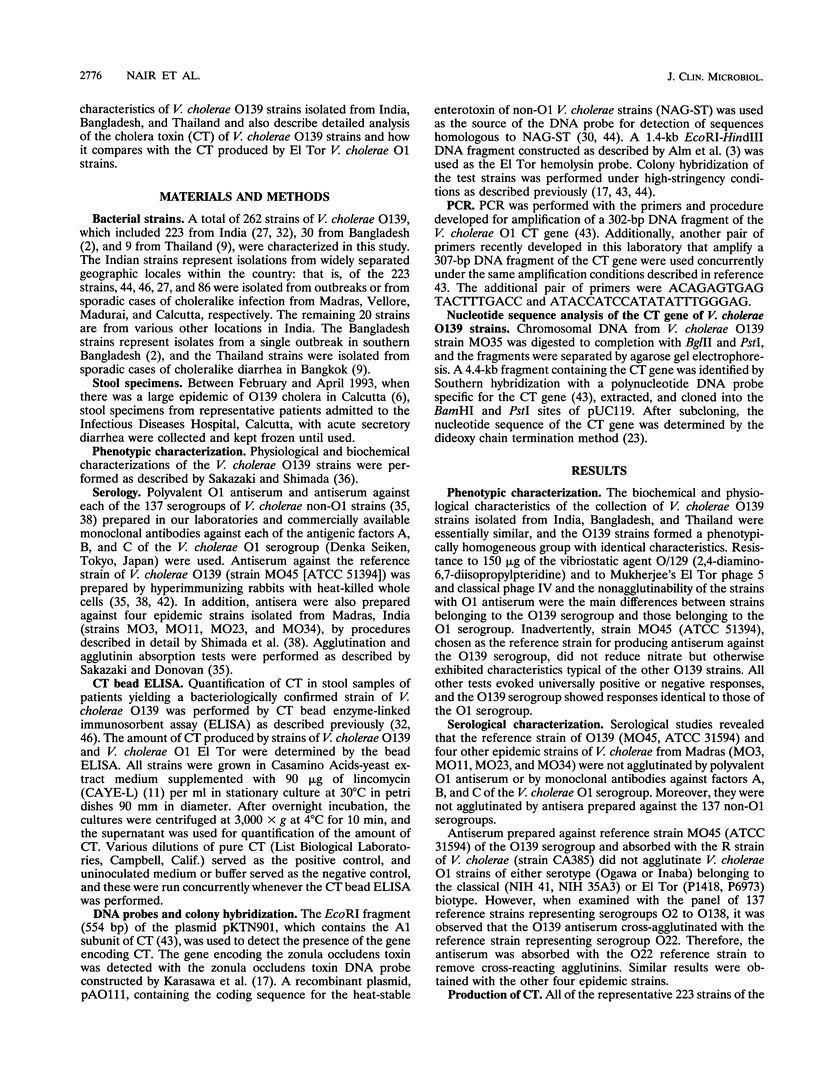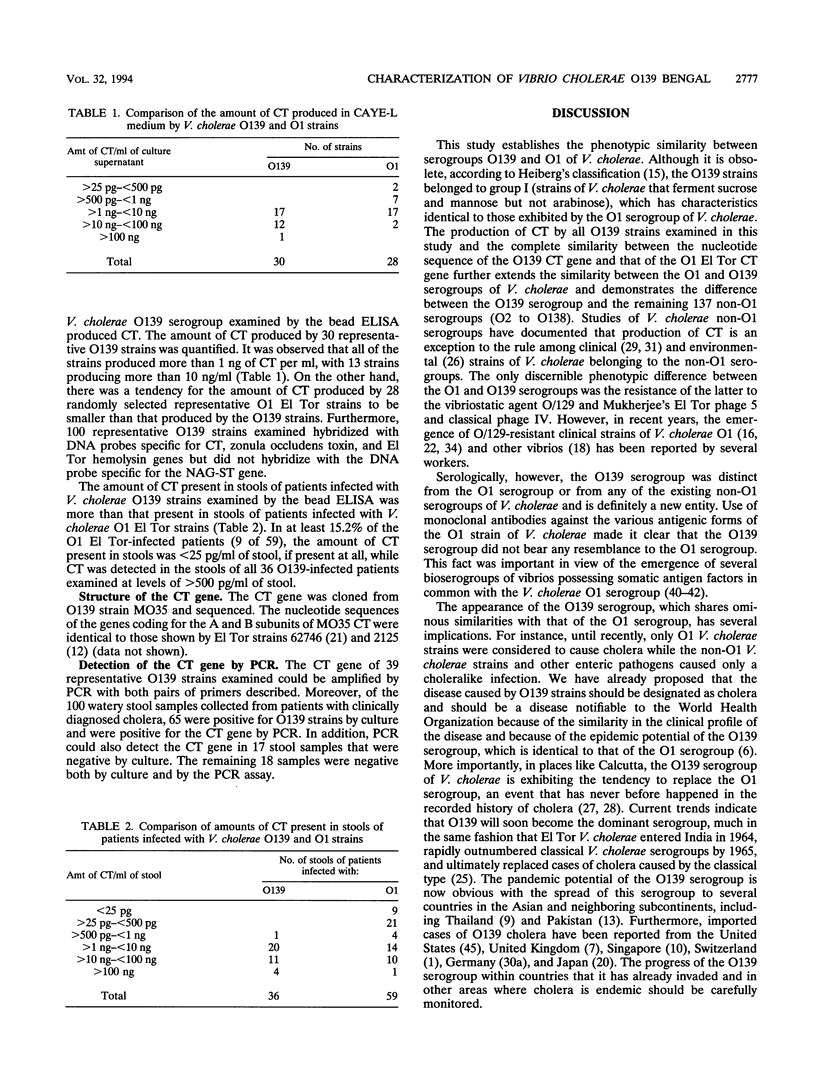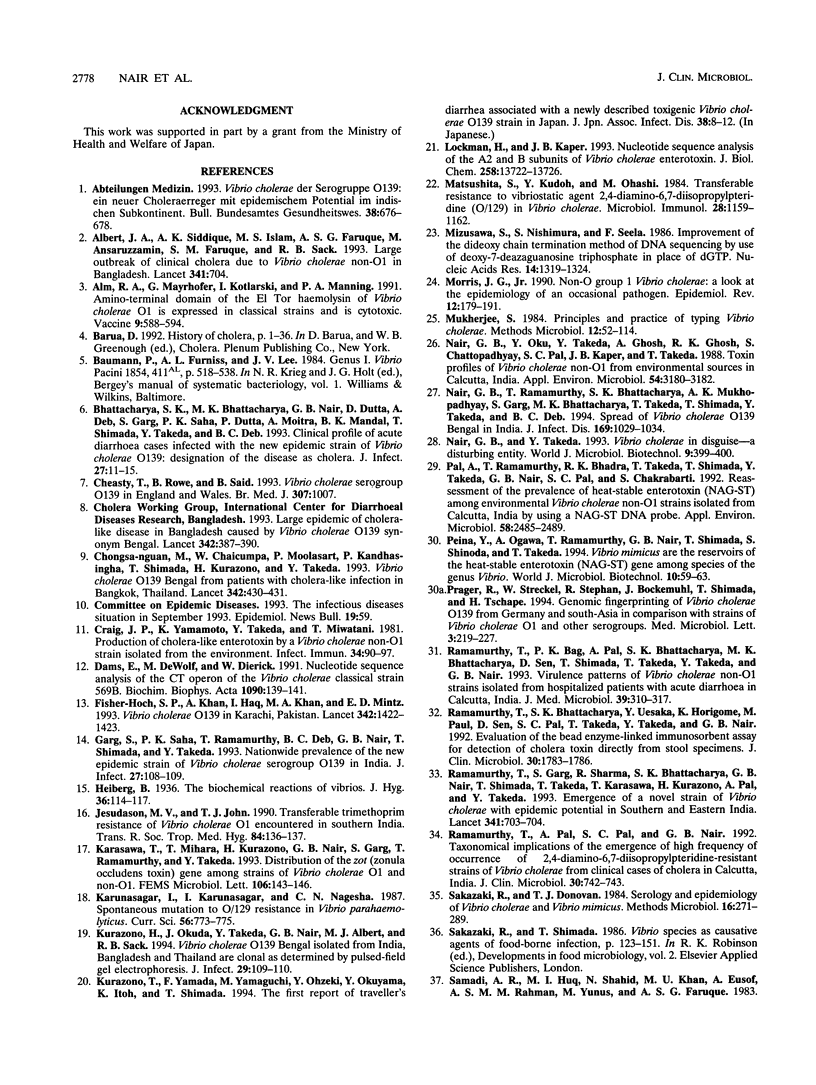Abstract
Biochemical and physiological traits of a collection of strains of Vibrio cholerae O139 Bengal isolated from India, Bangladesh, and Thailand showed that these strains formed a phenotypically homogeneous group with identical characteristics that were essentially similar to those of the O1 serogroup. Resistance to 150 micrograms of the vibriostatic agent O/129 (2,4-diamino-6,7-diisopropylpteridine) and Mukherjee's El Tor phage 5 and classical phage IV and the nonagglutinability of the strains with O1 antiserum were the only discernible differences between the O139 and O1 serogroups. Extensive serological characterization further revealed the O139 serogroup to be distinct from the existing 138 serogroups of V. cholerae. Antiserum raised against the O139 serogroup required absorption with the R reference strain CA385 and with the reference strain representing serogroup O22 to remove cross-reacting agglutinins. All of the 223 representative strains of V. cholerae O139 examined hybridized with DNA probes specific for the cholera toxin (CT) gene, zonula occludens toxin gene, and El Tor hemolysin gene but not with the probe specific for the heat-stable enterotoxin gene. The amount of CT present in stool samples of patients infected with the O139 serogroup was higher than that found in stools of patients infected with O1 El Tor, and this echoed findings that the amount of CT produced by O139 strains in vitro was higher than that produced by the O1 El Tor strains. The nucleotide sequences of the genes encoding the A and B subunits of CT of the O139 serogroup were identical to the sequences reported for the CT gene of O1 El Tor. The CT gene of O139 strains could be amplified by using primers developed for detection of the CT gene of the O1 serogroup by a PCR assay, which could also be used to detect the CT gene in stool samples of patients infected with strains of the O139 serogroup.
Full text
PDF




Selected References
These references are in PubMed. This may not be the complete list of references from this article.
- Albert M. J., Siddique A. K., Islam M. S., Faruque A. S., Ansaruzzaman M., Faruque S. M., Sack R. B. Large outbreak of clinical cholera due to Vibrio cholerae non-O1 in Bangladesh. Lancet. 1993 Mar 13;341(8846):704–704. doi: 10.1016/0140-6736(93)90481-u. [DOI] [PubMed] [Google Scholar]
- Alm R. A., Mayrhofer G., Kotlarski I., Manning P. A. Amino-terminal domain of the El Tor haemolysin of Vibrio cholerae O1 is expressed in classical strains and is cytotoxic. Vaccine. 1991 Aug;9(8):588–594. doi: 10.1016/0264-410x(91)90247-4. [DOI] [PubMed] [Google Scholar]
- Bhattacharya M. K., Bhattacharya S. K., Garg S., Saha P. K., Dutta D., Nair G. B., Deb B. C., Das K. P. Outbreak of Vibrio cholerae non-O1 in India and Bangladesh. Lancet. 1993 May 22;341(8856):1346–1347. doi: 10.1016/0140-6736(93)90855-b. [DOI] [PubMed] [Google Scholar]
- Bhattacharya S. K., Bhattacharya M. K., Nair G. B., Dutta D., Deb A., Ramamurthy T., Garg S., Saha P. K., Dutta P., Moitra A. Clinical profile of acute diarrhoea cases infected with the new epidemic strain of Vibrio cholerae O139: designation of the disease as cholera. J Infect. 1993 Jul;27(1):11–15. doi: 10.1016/0163-4453(93)93488-p. [DOI] [PubMed] [Google Scholar]
- Cheasty T., Rowe B., Said B., Frost J. Vibrio cholerae serogroup 0139 in England and Wales. BMJ. 1993 Oct 16;307(6910):1007–1007. doi: 10.1136/bmj.307.6910.1007-a. [DOI] [PMC free article] [PubMed] [Google Scholar]
- Chongsa-nguan M., Chaicumpa W., Moolasart P., Kandhasingha P., Shimada T., Kurazono H., Takeda Y. Vibrio cholerae O139 Bengal in Bangkok. Lancet. 1993 Aug 14;342(8868):430–431. doi: 10.1016/0140-6736(93)92841-g. [DOI] [PubMed] [Google Scholar]
- Craig J. P., Yamamoto K., Takeda Y., Miwatani T. Production of cholera-like enterotoxin by a Vibrio cholerae non-O1 strain isolated from the environment. Infect Immun. 1981 Oct;34(1):90–97. doi: 10.1128/iai.34.1.90-97.1981. [DOI] [PMC free article] [PubMed] [Google Scholar]
- Dams E., De Wolf M., Dierick W. Nucleotide sequence analysis of the CT operon of the Vibrio cholerae classical strain 569B. Biochim Biophys Acta. 1991 Aug 27;1090(1):139–141. doi: 10.1016/0167-4781(91)90050-v. [DOI] [PubMed] [Google Scholar]
- Fisher-Hoch S. P., Khan A., Inam-ul-Haq, Khan M. A., Mintz E. D. Vibrio cholerae O139 in Karachi, Pakistan. Lancet. 1993 Dec 4;342(8884):1422–1423. doi: 10.1016/0140-6736(93)92780-w. [DOI] [PubMed] [Google Scholar]
- Garg S., Saha P. K., Ramamurthy T., Deb B. C., Nair G. B., Shimada T., Takeda Y. Nationwide prevalence of the new epidemic strain of Vibrio cholerae O139 Bengal in India. J Infect. 1993 Jul;27(1):108–109. doi: 10.1016/0163-4453(93)94398-u. [DOI] [PubMed] [Google Scholar]
- Jesudason M. V., John T. J. Transferable trimethoprim resistance of Vibrio cholerae O1 encountered in southern India. Trans R Soc Trop Med Hyg. 1990 Jan-Feb;84(1):136–137. doi: 10.1016/0035-9203(90)90407-6. [DOI] [PubMed] [Google Scholar]
- Karasawa T., Mihara T., Kurazono H., Nair G. B., Garg S., Ramamurthy T., Takeda Y. Distribution of the zot (zonula occludens toxin) gene among strains of Vibrio cholerae 01 and non-01. FEMS Microbiol Lett. 1993 Jan 15;106(2):143–145. doi: 10.1111/j.1574-6968.1993.tb05950.x. [DOI] [PubMed] [Google Scholar]
- Kurazono H., Okuda J., Takeda Y., Nair G. B., Albert M. J., Sack R. B., Chongsa-nguan M., Chaicumpa W. Vibrio cholerae O139 Bengal isolated from India, Bangladesh and Thailand are clonal as determined by pulsed-field gel electrophoresis. J Infect. 1994 Jul;29(1):109–110. doi: 10.1016/s0163-4453(94)95357-0. [DOI] [PubMed] [Google Scholar]
- Kurazono T., Yamada F., Yamaguchi M., Ohzeki Y., Okuyama Y., Itoh K., Shimada T. [The first report of traveler's diarrhea associated with a newly described toxigenic Vibrio cholerae O139 strain in Japan]. Kansenshogaku Zasshi. 1994 Jan;68(1):8–12. doi: 10.11150/kansenshogakuzasshi1970.68.8. [DOI] [PubMed] [Google Scholar]
- Lockman H., Kaper J. B. Nucleotide sequence analysis of the A2 and B subunits of Vibrio cholerae enterotoxin. J Biol Chem. 1983 Nov 25;258(22):13722–13726. [PubMed] [Google Scholar]
- Matsushita S., Kudoh Y., Ohashi M. Transferable resistance to the vibriostatic agent 2,4-diamino-6,7-diisopropyl-pteridine (O/129) in Vibrio cholerae. Microbiol Immunol. 1984;28(10):1159–1162. doi: 10.1111/j.1348-0421.1984.tb00773.x. [DOI] [PubMed] [Google Scholar]
- Mizusawa S., Nishimura S., Seela F. Improvement of the dideoxy chain termination method of DNA sequencing by use of deoxy-7-deazaguanosine triphosphate in place of dGTP. Nucleic Acids Res. 1986 Feb 11;14(3):1319–1324. doi: 10.1093/nar/14.3.1319. [DOI] [PMC free article] [PubMed] [Google Scholar]
- Morris J. G., Jr Non-O group 1 Vibrio cholerae: a look at the epidemiology of an occasional pathogen. Epidemiol Rev. 1990;12:179–191. doi: 10.1093/oxfordjournals.epirev.a036052. [DOI] [PubMed] [Google Scholar]
- Nair G. B., Oku Y., Takeda Y., Ghosh A., Ghosh R. K., Chattopadhyay S., Pal S. C., Kaper J. B., Takeda T. Toxin profiles of Vibrio cholerae non-O1 from environmental sources in Calcutta, India. Appl Environ Microbiol. 1988 Dec;54(12):3180–3182. doi: 10.1128/aem.54.12.3180-3182.1988. [DOI] [PMC free article] [PubMed] [Google Scholar]
- Nair G. B., Ramamurthy T., Bhattacharya S. K., Mukhopadhyay A. K., Garg S., Bhattacharya M. K., Takeda T., Shimada T., Takeda Y., Deb B. C. Spread of Vibrio cholerae O139 Bengal in India. J Infect Dis. 1994 May;169(5):1029–1034. doi: 10.1093/infdis/169.5.1029. [DOI] [PubMed] [Google Scholar]
- Pal A., Ramamurthy T., Bhadra R. K., Takeda T., Shimada T., Takeda Y., Nair G. B., Pal S. C., Chakrabarti S. Reassessment of the prevalence of heat-stable enterotoxin (NAG-ST) among environmental Vibrio cholerae non-O1 strains isolated from Calcutta, India, by using a NAG-ST DNA probe. Appl Environ Microbiol. 1992 Aug;58(8):2485–2489. doi: 10.1128/aem.58.8.2485-2489.1992. [DOI] [PMC free article] [PubMed] [Google Scholar]
- Ramamurthy T., Bag P. K., Pal A., Bhattacharya S. K., Bhattacharya M. K., Shimada T., Takeda T., Karasawa T., Kurazono H., Takeda Y. Virulence patterns of Vibrio cholerae non-O1 strains isolated from hospitalised patients with acute diarrhoea in Calcutta, India. J Med Microbiol. 1993 Oct;39(4):310–317. doi: 10.1099/00222615-39-4-310. [DOI] [PubMed] [Google Scholar]
- Ramamurthy T., Bhattacharya S. K., Uesaka Y., Horigome K., Paul M., Sen D., Pal S. C., Takeda T., Takeda Y., Nair G. B. Evaluation of the bead enzyme-linked immunosorbent assay for detection of cholera toxin directly from stool specimens. J Clin Microbiol. 1992 Jul;30(7):1783–1786. doi: 10.1128/jcm.30.7.1783-1786.1992. [DOI] [PMC free article] [PubMed] [Google Scholar]
- Ramamurthy T., Garg S., Sharma R., Bhattacharya S. K., Nair G. B., Shimada T., Takeda T., Karasawa T., Kurazano H., Pal A. Emergence of novel strain of Vibrio cholerae with epidemic potential in southern and eastern India. Lancet. 1993 Mar 13;341(8846):703–704. doi: 10.1016/0140-6736(93)90480-5. [DOI] [PubMed] [Google Scholar]
- Ramamurthy T., Pal A., Pal S. C., Nair G. B. Taxonomical implications of the emergence of high frequency of occurrence of 2,4-diamino-6,7-diisopropylpteridine-resistant strains of Vibrio cholerae from clinical cases of cholera in Calcutta, India. J Clin Microbiol. 1992 Mar;30(3):742–743. doi: 10.1128/jcm.30.3.742-743.1992. [DOI] [PMC free article] [PubMed] [Google Scholar]
- Samadi A. R., Huq M. I., Shahid N., Khan M. U., Eusof A., Rahman A. S., Yunus M., Faruque A. S. Classical Vibrio cholerae biotype displaces EL tor in Bangladesh. Lancet. 1983 Apr 9;1(8328):805–807. doi: 10.1016/s0140-6736(83)91860-3. [DOI] [PubMed] [Google Scholar]
- Shimada T., Sakazaki R. A serogroup of non-O1 Vibrio cholerae possessing the Inaba antigen of Vibrio cholerae O1. J Appl Bacteriol. 1988 Feb;64(2):141–144. doi: 10.1111/j.1365-2672.1988.tb02733.x. [DOI] [PubMed] [Google Scholar]
- Shimada T., Sakazaki R., Mizushima M., Suzuki M. Two serogroups of Vibrio cholerae non-O1 possessing somatic antigen factors in common with Hakata serogroup of V. cholerae. Jpn J Med Sci Biol. 1990 Feb;43(1):1–6. doi: 10.7883/yoken1952.43.1. [DOI] [PubMed] [Google Scholar]
- Shimada T., Sakazaki R., Oue M. A bioserogroup of marine vibrios possessing somatic antigen factors in common with Vibrio cholerae O1. J Appl Bacteriol. 1987 May;62(5):453–456. doi: 10.1111/j.1365-2672.1987.tb02676.x. [DOI] [PubMed] [Google Scholar]
- Shirai H., Nishibuchi M., Ramamurthy T., Bhattacharya S. K., Pal S. C., Takeda Y. Polymerase chain reaction for detection of the cholera enterotoxin operon of Vibrio cholerae. J Clin Microbiol. 1991 Nov;29(11):2517–2521. doi: 10.1128/jcm.29.11.2517-2521.1991. [DOI] [PMC free article] [PubMed] [Google Scholar]
- Takeda T., Peina Y., Ogawa A., Dohi S., Abe H., Nair G. B., Pal S. C. Detection of heat-stable enterotoxin in a cholera toxin gene-positive strain of Vibrio cholerae O1. FEMS Microbiol Lett. 1991 May 1;64(1):23–27. doi: 10.1016/0378-1097(91)90203-m. [DOI] [PubMed] [Google Scholar]
- Uesaka Y., Otsuka Y., Kashida M., Oku Y., Horigome K., Nair G. B., Pal S. C., Yamasaki S., Takeda Y. Detection of cholera toxin by a highly sensitive bead-enzyme linked immunosorbent assay. Microbiol Immunol. 1992;36(1):43–53. doi: 10.1111/j.1348-0421.1992.tb01641.x. [DOI] [PubMed] [Google Scholar]


